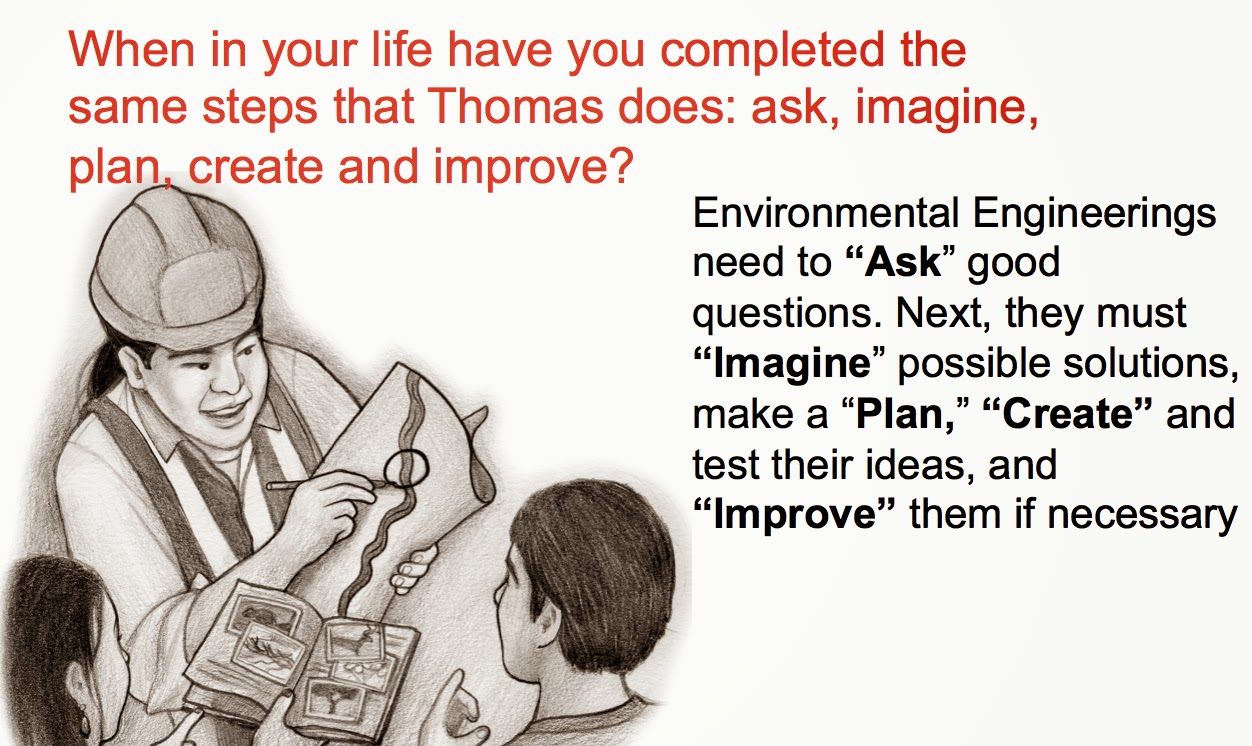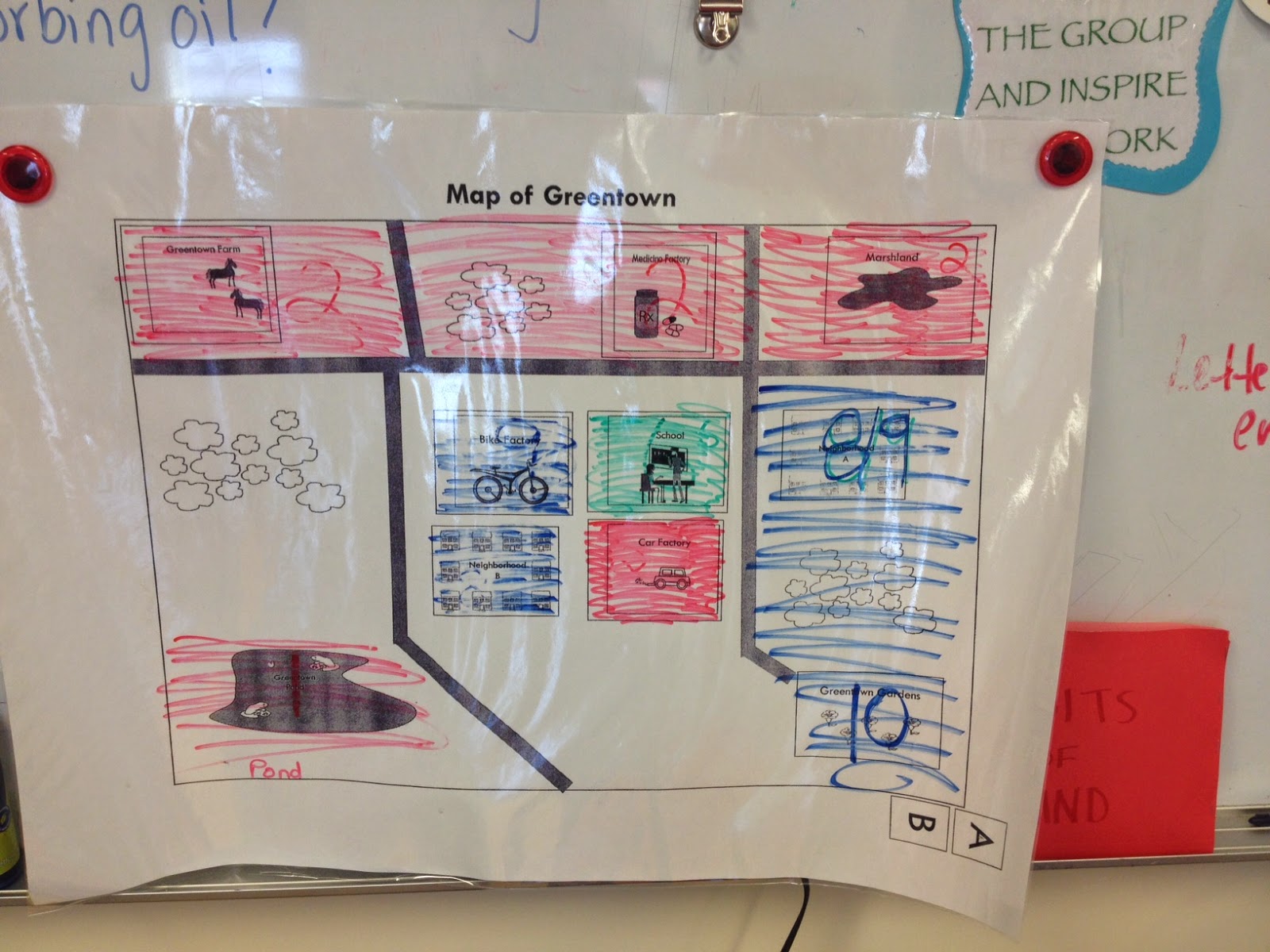What happens when you give 56 3rd graders the task of saving a town from certain environmental catastrophe? They rise to the occasion and do all they can to save it..with STEM!

Thanks to an amazing partnership funded by Raytheon for Engineering is Elementary (EiE) out of the Boston Museum of Science, Maury students are taking part in a variety of engineering units. I was also trained at an EiE Teacher Educator Institute, along side a great group of Einstein Fellows at NSF in January. All of that has led to what you are about to see: 3rd graders becoming environmental engineers!
Each of the EiE units begins with the question: What is technology? Students begin by brainstorming technologies and then looking more closely at things that they might not initially think of as such: plastic bags, paper clips etc. They come to the conclusion that technology is anything human-made that solves a problem or fulfills a desire. From there, they delve deeper into a specific engineering career, in this case, environmental engineering.
Students record information about their pieces of technology: paper clip and plastic bag.
To learn about this, all EiE units are framed in real-life context. For this unit, we learn from Teyha, a child in Washington State who witnesses the impact an oil spill has on her community and the ecosystem. Students look deeper into how interconnected ecosystems are and how imbalance in one area, even a small one, can have devastating, rippling effects. Through Teyha’s conversations with her friend Thomas ( who lucky for us happens to be an environmental engineer), students learn along with her that environmental engineers use their knowledge of math, science and creativity to solve an environmental problem. She also learns about the Engineering Design Process (EDP) and how it helps engineers in their work. ( All EiE units use the EDP as the guide through each lessons. Students complete all steps in their work.)
 |
| The EiE Engineering Design Process graphic. |
The book also introduces students to real life materials used to clean an oil spill, as well as any other content specific vocabulary they need for the unit.
Then comes the scientific testing! We turned to learning more about tests environmental engineers may actually use in their work by being introduced to the fictional city of “Greentown”. Students receive a “letter from the Mayor of Greentown, informing them that the frogs and plants were dying in the town and they learn why!
Students explore pH and how acidic and basic soil and water can effect an ecosystem. The “mayor” then sent soil and water samples from various places around the town for students to test and use that data to determine why the frogs and plants were dying.
Students tested the samples from various places around Greentown and recorded their data, comparing it to the base data from 3 years ago. As a teacher, things don’t always go as planned. Perhaps the samples I created were not done correctly, but as it turned out, our data wasn’t where it “needed to be” to continue with the lessons. ( For example, the medicine factory soil showed an initial pH of 7.0 when, according to the curriculum it should have read 2.0). This was a perfect learning experience for us though!
( Small clip framing the day with the “Mayor” calling in at 00:50)
 |
| I posted this letter but I also had my husband act as the mayor. Each time a letter was sent, we would get a voice recording “left on my phone” with our new assignment! |
 |
Students then transferred this data into a visual map of their own in their journals, allowing them to SEE in a larger scale where the problem spots were and then were asked: “Which areas do you think are causing the frogs to die in Greentown Pond and the plants to die in Greentown Gardens”? They had to use their knowledge of pH, ecosystems, stormwater runoff AND information sent by the “mayor” to figure out the mystery.
Here is an example of information students learned about one location in town.
Before students made their final recommendations to the Mayor of Greentown, I found it important to make connections to their real-lives, as well as provide more scientific information for them to use. In Greentown, one of the problem areas was where there was a road salt spill that was improperly cleaned up. During this unit, we happened to be in the middle of storm after storm, which made road salt ever present ( on the roads and literally all over the floor of our classroom). We took an additional class to look at this specific concern and after reaching out on Twitter, found two wonderful resources.
The first resource is a great animated short called ” A Drop’s Life” put out by DC Water. It is all about storm water runoff and why it is important to consider in a city like DC.
At the same time, I contacted Martin Andres Austermuhle, producer at WAMU, the DC National Public Radio affiliate who had popped up on my twitter feed. It turned out he was running a story about this exact issue!
You can read his story here: http://wamu.org/news/14/03/04/road_salt .
We even collected snow samples from our very own school grounds where salt had been spread and tested these samples to see how it made the water more basic!
With more information about the way pollutants can move through an ecosystem, plus real-life examples, students worked in teams to determine the main causes of frog and plant deaths. Groups shared their findings with the class and a few even called the Mayor. Again, kudos to my amazing husband for playing the part! ( I should note that at this point, students had figured out that my husband WAS the mayor, but it didn’t change how excited they got about the project!)
Once again, current events played a large role in my lesson planning. In March, there was a large oil spill near Galveston, Texas. To frame the importance of their work, I had the Mayor send the following message to the students, asking them to help the Mayor of Galveston and the REAL scientists and engineers working at that very moment to save as much as the ecosystem as possible.
( I would email my husband the script, he’d record it and send back. I’d play his voice recording over the photographs of the spill. Sadly, I can’t figure out how to imbed the audio!!)
 |
| Galveston, Texas boom from spill and birds effected. |
The third major step in this unit was to complete scientific tests to help inform their solutions. They had to complete controlled experiments with oil and a number of materials to determine how well each contained or absorbed oil.
With lots of help from parents and from a very special visitor ( Dr. David Evans, Executive Director of the National Science Teachers Association) students made predictions about if, and how well, 9 materials would absorb or contain oil.
 |
| Dr. David Evans introduces himself to the class before getting to “work” with our young scientists. (Photos courtesy of Robert Pohl) |
 |
| Using “C” sign for contain, “A” for absorb in predicting what materials would do when in contact with oil. |
| Testing each material. Recording results. |
 |
| Example of student observations. |
Once all materials had been tested, we came back in the next class and evaluated our methods and decided we had to test 5 of the materials again. After doing this, the class came up with the following:
The final step in this amazing learning odyssey, is for students to use this information to construct their own oil spill clean up devices. However, timing has it that….spring break happened…which is when I’m writing this update.
So what happens next? Well, when we return, this group of students will be embarking on their next unit, an amazing partnership in game design with Labyrinth Puzzles and Games. However, we can’t just leave this data hanging without completing the final challenge! 92% of the 56 3rd graders have jumped at the chance to complete the final step in this learning process: making their own oil spill clean- up device using what they learned about the materials! Students will be coming to me for three extra classes (recess environmental engineer club) where they will complete this final step.
If our budding environmental engineers’ work during this unit is any indication of the solutions they will create, I know they will show incredible scientifically grounded, creative solutions to this final challenge. Stay tuned for their amazing work!
Until next time,
-Vanessa Ford









